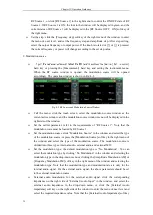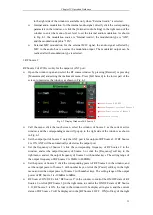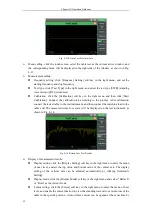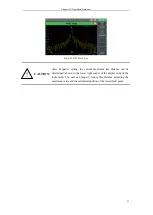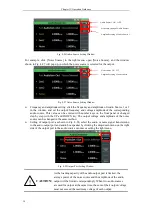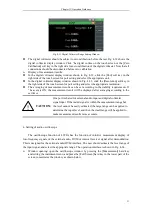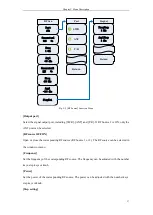
Chapter IV Operation Guidance
42
Menu calling: click the touch screen, select the cable test as the current active window, and
the corresponding menu will be displayed in the right side of the window, as shown in Fig.
4-17.
Measurement setting:
Frequency setting: click the [Frequency Setting] soft key in the right menu, and set the
starting frequency and stop frequency.
Setting of test type: click the [Test Type] soft key in the right menu and select the test type
[LOSS] (cable loss).
Calibration: click the [Calibration] soft key in the right menu and then click [Start
Calibration]. Connect the calibration kit according to the prompt. After calibration, connect
the tested cable to the test instrument. In order to ensure the accuracy of cable loss
measurement, connect the terminal of the tested cable to the open-circuit or short-circuit
device. The measured cable loss curve will be displayed on the test instrument, as shown in
Fig. 4-18.
Fig. 4-18 Cable Loss Test Results
Display of measurement results:
Display setting: click the [Display Setting] soft key in the right menu to enter the menu
of next level, and set the top value and bottom value of the vertical axis. The display
setting of the vertical axis can be adjusted automatically by clicking [Automatic
Setting].
Display mode: click the [Display Mode] soft key in the right menu and select “Refresh”
or “Hold” as the current mode.
Cursor setting: click the [Cursor] soft key in the right menu to enter the menu of next
level, and enable the cursor function to view the standing wave ratio or return loss of the
cable in the specific position. At most three cursors can be opened at the same time by
[ON OFF] setting. The cursor can be dragged into the ideal position by selecting the
[Position] soft key, or rapidly positioned by directly selecting the [Peak], [Left Peak] or
[Right Peak]. The normal or differential mode can be selected with the [Mode] soft key.
In the differential mode, two cursors can be compared intuitively. After the loss curve of
the tested cable is measured, the user can use the [Cursor] soft key to find the peak and
valley value of this loss curve. Then calculate the average to obtain the average loss of
the cable.
3. DTF measurement
DTF (Distance To Fault) measurement. i.e. fault point positioning measurement, is a kind of
performance verification and fault analysis tool used in the maintenance and repair process of
antenna and transmission lines. In engineering applications, the connection method shown in Fig.
Summary of Contents for 4992A
Page 1: ...I 4992A Radio Test Set User Manual China Electronics Technology Instruments Co Ltd...
Page 2: ......
Page 5: ......
Page 6: ......
Page 7: ......
Page 23: ...Article I Handling Instructions 11 Article I Handling Instructions...
Page 93: ...81 Article II Technical Specifications...
Page 132: ...Article III Maintenance Instructions 120 Article III Maintenance Instructions...

